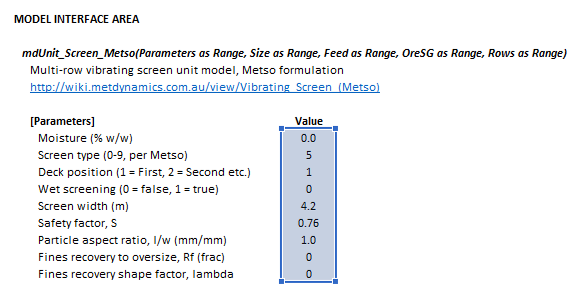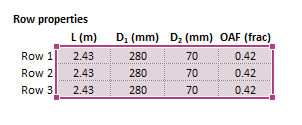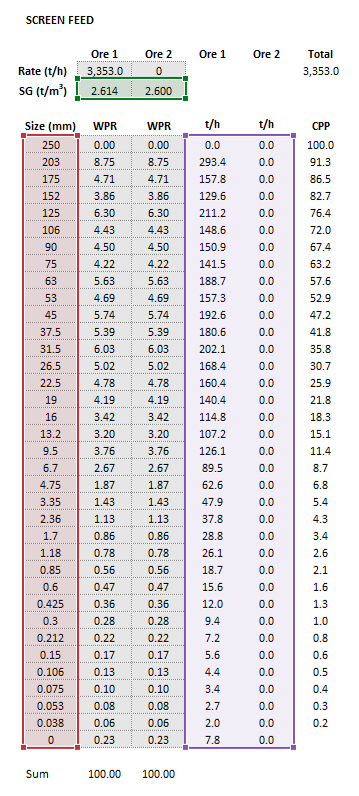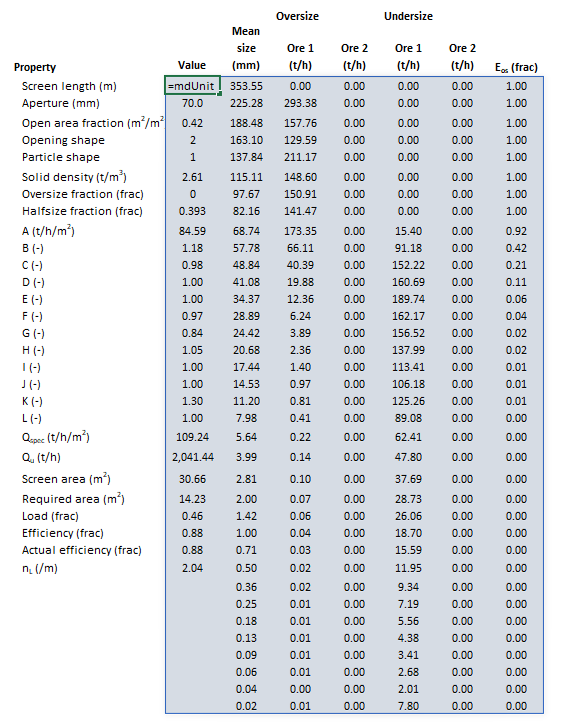Vibrating Screen (Metso): Difference between revisions
Scott Munro (talk | contribs) m (1 revision imported) |
imported>Scott.Munro |
||
| Line 121: | Line 121: | ||
The values of the factors <math>A</math>, <math>B</math>, <math>C</math>, <math>E</math>, and <math>L</math> are determined from the charts provided in Figures 1 - 5. | The values of the factors <math>A</math>, <math>B</math>, <math>C</math>, <math>E</math>, and <math>L</math> are determined from the charts provided in Figures 1 - 5. | ||
Factors <math>D</math>, <math>H</math>, <math>I</math> and <math>K</math> are | Note that Factor <math>E</math> is only applied during wet screening, where water is added to the feed or screen deck, and assumes a value of 1.0 otherwise. Similarly, the moisture factor <math>L</math> is only applied during dry screening and adopts a value for 1.0 for wet screening applications. | ||
Factors <math>D</math>, <math>H</math>, <math>I</math> and <math>K</math> are determined by consulting Tables 1 - 4. | |||
Factor <math>F</math> is defined as: | Factor <math>F</math> is defined as: | ||
| Line 163: | Line 165: | ||
* The length of the screen (<math>l</math>) is the sum of the length of all defined rows. | * The length of the screen (<math>l</math>) is the sum of the length of all defined rows. | ||
* The aperture of the screen is defined as the smallest aperture dimension of all defined rows. | * The aperture of the screen is defined as the smallest aperture dimension of all defined rows. | ||
* The open area fraction of the screen is the row length-weighted average of the fraction open areas (<math>f_{\rm o}</math> of all defined rows. | * The open area fraction of the screen is the row length-weighted average of the fraction open areas (<math>f_{\rm o}</math>) of all defined rows. | ||
=== Screen efficiency === | === Screen efficiency === | ||
Revision as of 00:56, 24 August 2023
Description
This article describes an implementation of the vibrating screen sizing methodology described by Metso (Viilo, 2011), coupled with the classification methods of Whiten and White (1977), Dehghani et al. (2002), and Firth and Hart (2008).[1][2][3][4]
Model theory
This model estimates the undersize transmission capacity of a given vibrating screen, from which the load and efficiency may be determined. The efficiency value is subsequently used to determine the classification performance of the screen, as outlined below.
Screen capacity
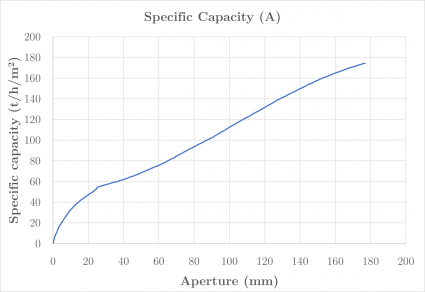 Figure 1. Specific screen capacity (after Viilo, 2011).[1] |
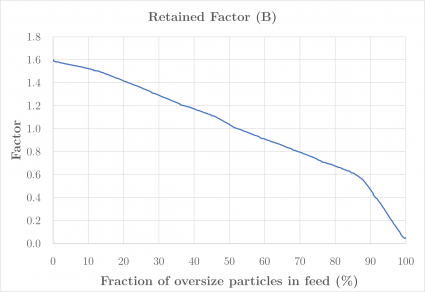 Figure 2. Retained material factor, B (after Viilo, 2011).[1] | ||||||||||||||||||||||||||||||||||||||||||||||||||||||||||||||||
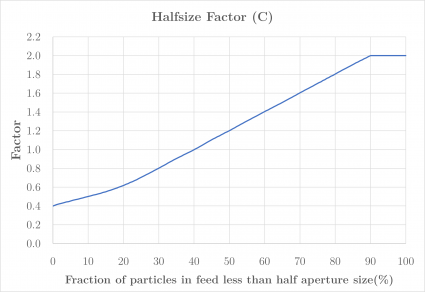 Figure 3. Half-size factor, C (after Viilo, 2011).[1]. |
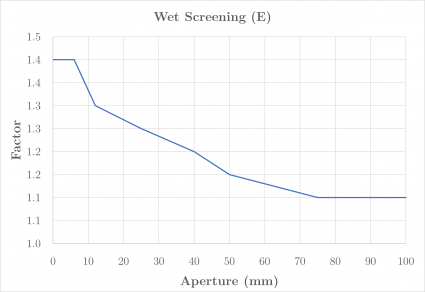 Figure 4. Wet screening factor, E (after Viilo, 2011).[1] | ||||||||||||||||||||||||||||||||||||||||||||||||||||||||||||||||
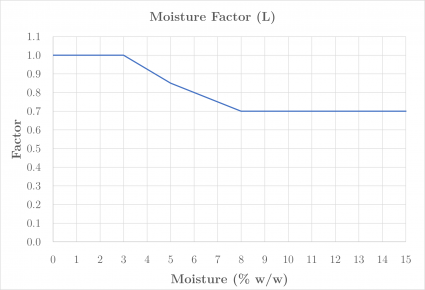 Figure 5. Moisture factor, L, (after Viilo, 2011).[1] |
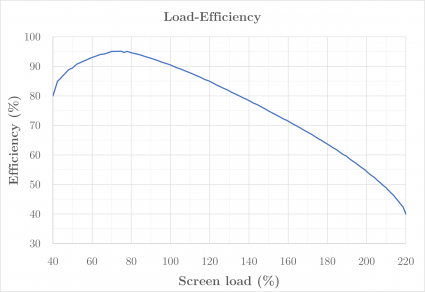 Figure 6. Screen load-efficiency relationship (after Viilo, 2011).[1] | ||||||||||||||||||||||||||||||||||||||||||||||||||||||||||||||||
| |||||||||||||||||||||||||||||||||||||||||||||||||||||||||||||||||
Viilo (2011) outlines a method for the sizing of vibrating screens for a given feed duty and desired separation.[1]
The screen sizing method may be reversed for already existing screens and used to determine the nominal throughput capacity. The nominal capacity may be compared to the actual feed duty to generate a screen load performance parameter, from which the screen efficiency may be determined.
The specific screening capacity, (t/h/m2) is defined as:
where:
- is the specific screening capacity (t/h/m2)
- is the retained (oversize) factor (-)
- is the halfsize factor (-)
- is the deck position factor (-)
- is the wet screening factor (-)
- is the material weight factor (-)
- is the surface open area factor (-)
- is the shape of the surface opening factor (-)
- is the particle shape factor (-)
- is the efficiency factor, which equals 1.0 for the reverse screening calculation (-)
- is the screen type factor (-)
- is the moisture factor (-)
The values of the factors , , , , and are determined from the charts provided in Figures 1 - 5.
Note that Factor is only applied during wet screening, where water is added to the feed or screen deck, and assumes a value of 1.0 otherwise. Similarly, the moisture factor is only applied during dry screening and adopts a value for 1.0 for wet screening applications.
Factors , , and are determined by consulting Tables 1 - 4.
Factor is defined as:
where is the solid density (t/m3), and Factor is:
where is the open area fraction of the screen deck (m2/m2).
The screen load (frac) is then defined as the "ratio of the flow rate of sub-aperture particles in the feed to the undersize transmission capacity of the screen", i.e.:
where:
- is the mass flow rate of particles in the feed stream (t/h)
- is the mass fraction of particles in the feed which are smaller than the aperture size (w/w)
- is the screen length in the direction of flow (m)
- is the screen width in the transverse direction to flow (m)
- is the screen safety factor (-)
The safety factor, , is typically 1.0, but may be adjusted to match performance data where some aspects of the screen design are unknown.
The target screen efficiency of undersize removal, (frac), may then be determined from the screen load via Figure 6.
A classification-by-size relationship is subsequently applied to the screen feed to yield the estimated screen efficiency.
Classification
This model applies a modified version of the Whiten and White (1977) expression for classification of particles to oversize:[2]
where:
- is the diameter of a particle (mm)
- is the corrected fraction of particles of size in the feed reporting to the oversize stream (frac)
- is the number of trials per unit length parameter (/m)
- is the length of the screening area (or panel) in the direction of flow (m)
- is the fraction open area of the screen deck/panels (m2/m2)
- is length (the longer side) of the screen deck/panel aperture (m)
- is width (the shorter side) of the screen deck/panel aperture (m)
Multi-row screening
Figure 7 indicates a typical arrangement of screen panels on a screen deck. Each row of panels may exhibit a unique set of properties. Particles in the screen feed may therefore experience changing apertures sizes or open area fractions during screening, in the order of row arrangement in the flow direction.
Screening across the rows of a deck with differing properties is analogous to an arrangement of screens in series, where the oversize from the first screen (row) becomes the feed to the next screen (row), and so on. This concept is illustrated in Figures 8 and 9.
Mathematically, this is stated as:
and adjusted for the entrainment of fines by:
where:
- is the corrected fraction of the feed to the screen deck in size interval recovered to the deck oversize stream (frac)
- is the corrected fraction of the feed to panel row in size interval recovered to the row oversize stream (frac)
- is the actual fraction of the feed to the screen deck in size interval recovered to the deck oversize stream (frac)
- is the number of panel rows with apertures permitting the passage of particles
Classification for each row is computed via the modified Whiten and White equation presented above. The same parameter is applied to all rows as a simplification.
Note: For the purposes of screen capacity and efficiency calculations:
- The length of the screen () is the sum of the length of all defined rows.
- The aperture of the screen is defined as the smallest aperture dimension of all defined rows.
- The open area fraction of the screen is the row length-weighted average of the fraction open areas () of all defined rows.
Screen efficiency
Screen efficiency, or the efficiency of undersize removal, (frac), is defined as "the fraction of sub-aperture material in the feed stream which is actually recovered to the undersize stream". Formally,
where:
- is the mass flow rate of particles in the undersize stream (t/h)
- is the mass flow rate of particles in the feed stream (t/h)
- is the mass fraction of particles in the feed which are smaller than the aperture size (w/w)
The screen model automatically adjusts the classification parameter to match to the target efficiency value, , determined by the screen capacity relationships above.
Multiple decks
Screens with multiple decks can be simulated by stacking model instances, i.e.:
- The undersize stream from the first deck becomes the feed to the next deck, and so on.
- Each deck yields an oversize stream, which can remain separated or combined into an overall oversize stream, depending on the screen and circuit configuration.
The overall efficiency of a multi-deck screen may be computed with the screen feed and final deck undersize streams in place of deck feed and deck undersize.
Excel
The Metso vibrating screen model may be invoked from the Excel formula bar with the following function call:
=mdUnit_Screen_Metso(Parameters as Range, Size as Range, Feed as Range, OreSG as Range, Rows as Range)
Invoking the function with no arguments will print Help text associated with the model, including a link to this page.
Inputs
The required inputs are defined below in matrix notation with elements corresponding to cells in Excel row () x column () format:
where:
- is the mass fraction of moisture in the screen feed (% w/w)
- is the deck slope and motion characteristic of the screen:
- 0 = Horizontal, Straight, Linear
- 1 = Horizontal, Straight, Const. Elliptical
- 2 = Inclined, Straight, Circular
- 3 = Inclined, Straight, Variable Elliptical
- 4 = Inclined, Straight, Linear
- 5 = Multislope, Linear
- 6 = Multislope, Triple slope, Variable Elliptical
- 7 = Multislope, Dual slope, Linear
- 8 = Multislope, Dual slope, Variable Elliptical
- 9 = Ignore
- indicates whether the wet screening factor, , should be applied (True/False)
- is the size of the square mesh interval that feed mass is retained on (mm)
- is the number of ore types
- is feed solids mass flow rate by size and ore type (t/h)
Results
The results are displayed in Excel as an array corresponding to the matrix notation below:
where:
- is the smallest aperture dimension of all defined rows (mm)
- is the shape of the apertures (= 0 if all defined rows have square apertures, = 1 otherwise)
- is the shape of the feed particles based on the aspect ratio (= 1 if , = 2 otherwise)
- is the fraction of feed particles larger than the aperture size, i.e. (frac)
- is the fraction of feed particles smaller than the half the aperture size, i.e. (frac)
- is the mass flow rate of particles in the feed smaller than the aperture size, i.e. (frac)
- is the total area of all defined rows, i.e. (m2)
- is the area required to screen the given feed at 100% load, i.e. (m2)
- is the target efficiency of undersize removal required by the screen capacity calculations (frac)
- is the actual efficiency of undersize removal achieved by the screen (frac)
- is number of trials parameter (/m) required to achieve the target efficiency (/m)
- is mass flow rate of solids to the oversize stream (t/h)
- is mass flow rate of solids to the undersize stream (t/h)
Example
The images below show the selection of input arrays and output results in the Excel interface.
SysCAD
The sections and variable names used in the SysCAD interface are described in detail in the following tables.
Note that a Deck and Partition page is provided provided for each connected oversize discharge stream.
MD_Screen page
The first tab page in the access window will have this name.
| Tag (Long/Short) | Input / Display | Description/Calculated Variables/Options |
|---|---|---|
| Tag | Display | This name tag may be modified with the change tag option. |
| Condition | Display | OK if no errors/warnings, otherwise lists errors/warnings. |
| ConditionCount | Display | The current number of errors/warnings. If condition is OK, returns 0. |
| GeneralDescription / GenDesc | Display | This is an automatically generated description for the unit. If the user has entered text in the 'EqpDesc' field on the Info tab (see below), this will be displayed here.
If this field is blank, then SysCAD will display the unit class ID. |
| Requirements | ||
| On | CheckBox | This enables the unit. If this box is not checked, then the MassFracToOS option appears below. |
| MassFracToOS | Input | Only appears if the On field above is not checked. Specifies the fraction of feed mass that reports to the overflow stream when the model is off. |
| NumParallelUnits | Input | The number of parallel, identical units to simulate:
|
| Options | ||
| ShowQFeed | CheckBox | QFeed and associated tab pages (eg Sp) will become visible, showing the properties of the combined feed stream. |
| SizeForPassingFracCalc | Input | Size fraction for % Passing calculation. The size fraction input here will be shown in the Stream Summary section. |
| FracForPassingSizeCalc | Input | Fraction passing for Size calculation. The fraction input here will be shown in the Stream Summary section. |
| Stream Summary | ||
| MassFlow / Qm | Display | The total mass flow in each stream. |
| SolidMassFlow / SQm | Display | The Solids mass flow in each stream. |
| LiquidMassFlow / LQm | Display | The Liquid mass flow in each stream. |
| VolFlow / Qv | Display | The total Volume flow in each stream. |
| Temperature / T | Display | The Temperature of each stream. |
| Density / Rho | Display | The Density of each stream. |
| SolidFrac / Sf | Display | The Solid Fraction in each stream. |
| LiquidFrac / Lf | Display | The Liquid Fraction in each stream. |
| Passing | Display | The mass fraction passing the user-specified size (in the field SizeForPassingFracCalc) in each stream. |
| Passes | Display | The user-specified (in the field FracForPassesSizeCalc) fraction of material in each stream will pass this size fraction. |
Deck page
The Deck page is used to specify the required model method and associated input parameters.
| Tag (Long/Short) | Input / Display | Description/Calculated Variables/Options |
|---|---|---|
| Deck | ||
| On | Checkbox | This enables the deck. If off, the feed to this deck passes directly to the next deck (or undersize) without partition. |
| Method | Partition (User) | The partition to oversize for each size interval is defined by the user. Different values can be used for different solids. |
| Partition (Reid-Plitt) | The partition to oversize for each size interval is defined by a Reid-Plitt efficiency curve. Different parameters can be used for different solids. | |
| Partition (Whiten-Beta) | The partition to oversize for each size interval is defined by a Whiten-Beta efficiency curve. Different parameters can be used for different solids. | |
| Vibrating (Karra) | The Karra vibrating screen model is used to determine the partition of solids to oversize and undersize for each size interval. | |
| Vibrating (Whiten) | The Whiten vibrating screen model is used to determine the partition of solids to oversize and undersize for each size interval. | |
| Vibrating (Metso) | The Metso vibrating screen model is used to determine the partition of solids to oversize and undersize for each size interval. | |
| Fine Wet (Mwale) | The Mwale fine wet screen model is used to determine the partition of solids to oversize and undersize for each size interval. | |
| Dewatering (Ng) | The Ng dewatering screen model is used to determine the moisture content of oversize material, and the partition of solids to oversize and undersize for each size interval. | |
| HelpLink | Opens a link to this page using the system default web browser. Note: Internet access is required. | |
| Parameters | ||
| ScreenType | Ignore | The screen type factor (K) is ignored |
| Horizontal, Straight, Linear | The screen deck slope and motion configuration selected from Table 4. | |
| Horizontal, Straight, Const. Ellip. | ||
| Inclined, Straight, Circular | ||
| Inclined, Straight, Var. Ellip. | ||
| Inclined, Straight, Linear | ||
| Multislope, Linear | ||
| Multislope, Triple slope, Var. Ellip. | ||
| Multislope, Dual slope, Linear | ||
| Multislope, Dual slope, Var. Ellip. | ||
| WetScreening | True/False | Indicates if the deck is wet screening (sprays, slurry etc). |
| DeckPosition | Input | Position of the deck, 1 = First, 2 = Second etc. |
| ScreenWidth / W | Input | Width of the screen. |
| SafetyFactor / S | Input | Value of the safety factor S. |
| ParticleAspectRatio / ParticleAR | Input | Value of the particle aspect ratio, i.e. (second longest dimension):(longest dimension). |
| Rf | Input | Fines recovery parameter, fraction of the finest particles or liquids split to oversize stream. |
| Lambda | Input | Fines recovery parameter, shape factor. |
| Rows | ||
| NumRows | Input | Number of screen panel rows. |
| L | Input | Length of the row in the direction of travel. |
| D1 | Input | Aperture length. |
| D2 | Input | Aperture width. |
| OpenArea / fo | Input | Open area fraction of the row. |
| Liquids | ||
| LiquidsSeparMethod | Split To OS (User) | Liquids are split to oversize by a user-defined fraction of liquids in the feed. |
| Split To OS (Rf) | Liquids are split to oversize by the Rf fraction specified for the screen model. | |
| OS Solids Fraction | Sufficient liquids mass is recovered to the oversize stream to yield the user-defined oversize solids mass fraction value (if possible). | |
| OS Liquids Fraction | Sufficient liquids mass is recovered to the oversize stream to yield the user-defined oversize liquids mass fraction value (if possible). | |
| OSSolidsFracReqd / OS.SfReqd | Input | Required value of the mass fraction of solids in the oversize stream. Only visible if OS Solids Fraction is selected. |
| OSLiquidsFracReqd / OS.LfReqd | Input | Required value of the mass fraction of liquids in the oversize stream. Only visible if OS Liquids Fraction is selected. |
| LiqSplitToOS / OS.LiqSplit | Input/Display | The fraction of feed liquids recovered to the oversize stream. |
| Results | ||
| ScreenLength | Display | Total length of all defined rows. |
| Aperture | Display | Smallest aperture dimension of all defined rows. |
| OpenAreaFraction / OAF | Display | Average open area fraction of all defined rows. |
| OpeningShape | Round | Aperture shape is round. |
| Square | Aperture shape is square based on aperture dimensions of all rows. | |
| Rectangular | Aperture shape is rectangular based on aperture dimensions of all rows. | |
| ParticleShape | Rounded | Particle shape is rounded. |
| Cubical | Particle shape is cubical based on particle aspect ratio. | |
| Flaky | Particle shape is flaky based on particle aspect ratio. | |
| SolidsDensity / SRho | Display | Combined density of all solids with a particle size distribution property. |
| Oversize | Display | Fraction of oversize particles in deck feed. |
| Halfsize | Display | Fraction of half-size particles in deck feed. |
| Factor | ||
| BasicCapacity / A | Display | Basic capacity of the screen. |
| OversizeFactor / B | Display | Particle oversize factor. |
| HalfSizeFactor / C | Display | Particle half-size factor. |
| DeckPosition / D | Display | Deck location factor. |
| WetScreening / E | Display | Wet screening factor. |
| MaterialWeight / F | Display | Material weight (density) factor. |
| SurfaceOpenArea / G | Display | Open area factor. |
| OpeningShape / H | Display | Opening shape factor. |
| ParticleShape / I | Display | Particle shape factor. |
| Efficiency / J | Display | Efficiency factor. |
| ScreenType/ K | Display | Screen type factor. |
| Moisture / L | Display | Feed moisture factor. |
| Load-Efficiency | ||
| AvailableArea | Display | Area available for screening, i.e. total screen length x width. |
| RequiredArea | Display | Screening area required to treat feed stream at 100% loading. |
| Load | Display | Ratio of the flow rate of sub-aperture particles in the deck feed to the undersize transmission capacity of the deck. |
| Efficiency | Display | Fraction of total sub-aperture sized material in deck feed that is actually recovered to the deck undersize stream. |
Partition page
The Partition page is used to display (or specify) the partition by species/component/element/individual phase and size values.
| Tag (Long/Short) | Input / Display | Description/Calculated Variables/Options |
|---|---|---|
| Distribution | ||
| Name | Display | Shows the name of the SysCAD Size Distribution (PSD) quality associated with the feed stream. |
| IntervalCount | Display | Shows the number of size intervals in the SysCAD Size Distribution (PSD) quality associated with the feed stream. |
| SpWithPSDCount | Display | Shows the number of species in the feed stream assigned with the SysCAD Size Distribution (PSD) quality. |
| Partition | ||
| Method | Model / User | Select model-calculated or user-defined partition to separate each solids species type. |
| Density | Display | Density of each solid species. |
| Size | Display | Size of each interval in mesh series. |
| MeanSize | Display | Geometric mean size of each interval in mesh series.
|
| All (All column) | Display |
|
| Partition | Display |
|
| All (All row, All column) | Display |
|
| All (All row, per species) | Display |
|
| CmpPartition | ||
| Components | Hides or shows component partition table. | |
| Size | Display | Size of each interval in mesh series. |
| MeanSize | Display | Geometric mean size of each interval in mesh series. |
| All (All column) | Display |
|
| CmpPartition | Display |
|
| All (All row, All column) | Display |
|
| All (All row, per component) | Display |
|
| ElePartition | ||
| Elements | Hides or shows element partition table. | |
| Size | Display | Size of each interval in mesh series. |
| MeanSize | Display | Geometric mean size of each interval in mesh series. |
| All (All column) | Display |
|
| ElePartition | Display |
|
| All (All row, All column) | Display |
|
| All (All row, per element) | Display |
|
| IPhPartition | ||
| IPhases | Hides or shows individual phases partition table. | |
| Size | Display | Size of each interval in mesh series. |
| MeanSize | Display | Geometric mean size of each interval in mesh series. |
| All (All column) | Display |
|
| IPhPartition | Display |
|
| All (All row, All column) | Display |
|
| All (All row, per individual phase) | Display |
|
About page
This page is provides product and licensing information about the Met Dynamics Models SysCAD Add-On.
| Tag (Long/Short) | Input / Display | Description/Calculated Variables/Options |
|---|---|---|
| About | ||
| HelpLink | Opens a link to the Installation and Licensing page using the system default web browser. Note: Internet access is required. | |
| Information | Copies Product and License information to the Windows clipboard. | |
| Product | ||
| Name | Display | Met Dynamics software product name |
| Version | Display | Met Dynamics software product version number. |
| BuildDate | Display | Build date and time of the Met Dynamics Models SysCAD Add-On. |
| License | ||
| File | This is used to locate a Met Dynamics software license file. | |
| Location | Display | Type of Met Dynamics software license or file name and path of license file. |
| SiteCode | Display | Unique machine identifier for license authorisation. |
| ReqdAuth | Display | Authorisation level required, MD-SysCAD Full or MD-SysCAD Runtime. |
| Status | Display | License status, LICENSE_OK indicates a valid license, other messages report licensing errors. |
| IssuedTo | Display | Only visible if Met Dynamics license file is used. Name of organisation/seat the license is authorised to. |
| ExpiryDate | Display | Only visible if Met Dynamics license file is used. License expiry date. |
| DaysLeft | Display | Only visible if Met Dynamics license file is used. Days left before the license expires. |
Additional notes
- Solid species that do not possess a particle size distribution property are split according to the overall mass split of the default particle size distribution species selected in the SysCAD Project Configuration.
- If the default particle size distribution species is not present in the unit feed, the overall split of all other species with particle size distributions combined is used, as determined by the model.
- Gas phase species report directly to the undersize stream without split.
References
- ↑ 1.0 1.1 1.2 1.3 1.4 1.5 1.6 1.7 Viilo, K. (ed), 2011. Crushing and Screening Handbook, 5th Edition. Metso.
- ↑ 2.0 2.1 Whiten, W.J. and White, M.E., 1977. Modelling and simulation of high tonnage crushing plants. In: Proceedings of the 12th International Mineral Processing Congress, vol. II. Sao Paulo, pp. 148–158.
- ↑ Dehghani, A., Monhemius, A.J. and Gochin, R.J., 2002. Evaluating the Nakajima et al. model for rectangular-aperture screens. Minerals engineering, 15(12), pp.1089-1094.
- ↑ Firth, B. and Hart, G., 2008. Some aspects of modeling partition curves for size classification. International journal of coal preparation and utilization, 28(3), pp.174-187.
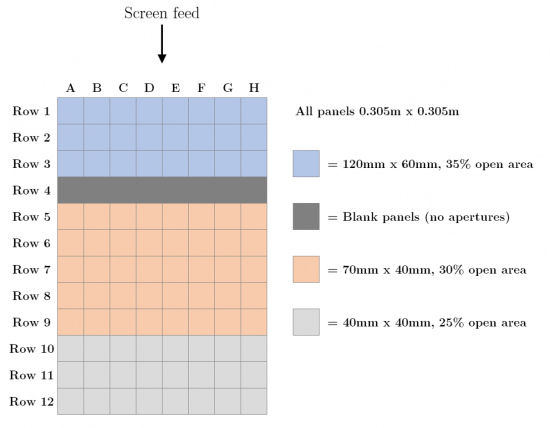



























![{\displaystyle E_{{\rm {oc}}s}={\begin{cases}\exp(-n_{L}Lf_{\rm {o}}{\dfrac {{\big [}D_{1}-s{\big ]}{\big [}D_{2}-s{\big ]}}{D_{1}D_{2}}})&s<D_{2}\\1.0&s\geq D_{2}\\\end{cases}}}](https://wikimedia.org/api/rest_v1/media/math/render/svg/b064eb8f4289908faa6102b0d66e617f4de33c71)











































